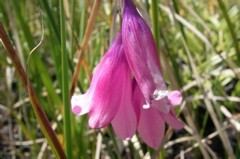
Rosmarinus officianalis 'Tuscan Blue'
A dense growing multi stemmed variety prized for topiary and hedging, featured at Sissinghurst Castle. Bright blue flowers.


Native grassland species from Natal, dwarf and florific with violet purple flowers earlier than most other varieties.
Native grassland species from Natal, dwarf and florific with violet purple flowers earlier than most other varieties.
Data sheet
A dense growing multi stemmed variety prized for topiary and hedging, featured at Sissinghurst Castle. Bright blue flowers.
Old fashioned "catmint", mostly used as a border or edging in cottage gardens. Soft blue flowers, trim lightly in mid summer for a repeat flower in autumn.
This is the rarely offered white form, lovely cut flower and cottage garden perennial. To grow effectively, avoid winter wet as much as possible and grow in a raised bed or well drained soil.
White form of Echinacea purpurea with attractive seedheads after flowering. Prolific and beautiful.
Old fashioned spreading grey foliage plant for amongst roses and perennials. Easy and dry tolerant.
Attractive dark stemmed form of Hydrangea macrophylla, flowers can vary from blue in acid soil or pink in alkaline. Old fashioned mop top flowers, good for floral work.
Our own breeding from Astrantia 'Hadspen Blood' ,very dark ruby red flowers. Astrantia, although tough once established, love moist clay loam soils and plenty of fertility to give their best. Division grown.
A good salvia for open positions where it gets plenty of sun. Long flowering from mid summer onwards with literally hundreds of light blue flowers. Trim back annually like a lavender for best long term results.
A terrific Dahlia with massive blooms and a subtle faded soft pink colour like old roses. Only a few in stock.
Strong upright variety great for amongst grasses and floral work. Best on drained soils. Cut to the ground in winter every 2-3 years when growth congested.
A wonderful new grey foliage variety with lilac flowers, which eventually turns into a small shrub. Very drought tolerant and evergreen throughout the year. Treat like a lavender with a light trim after flowering.
Spreading perennial for moist areas with attractive musk-pink drumstick flowers in summer. Best result in cooler climates with morning sun on fertile soil.
Stunning double flowered paeonia requiring rich well drained soil in full sun, young plants often takes a year or two to establish but eventually form large clumps; we recommend removing first flowers to hasten establishment.
Ornamental bronze tinged foliage plant for pond margins and clay soils; associates well with gunnera, filipendula, and Iris. Best in part shade, native to China and Japan.
A dark flowered seedling I selected at Richard Bramleys "Farmyard Nursery" in Wales. An improvement on "Moerheim Beauty", with deep orange red flowers in mid to late summer.
A pretty species which grows well in the garden. Reddish pink flared bells on 140 cm stems, native to the eastern Drakensberg region, where it is said to cover complete hillsides.

Native grassland species from Natal, dwarf and florific with violet purple flowers earlier than most other varieties.